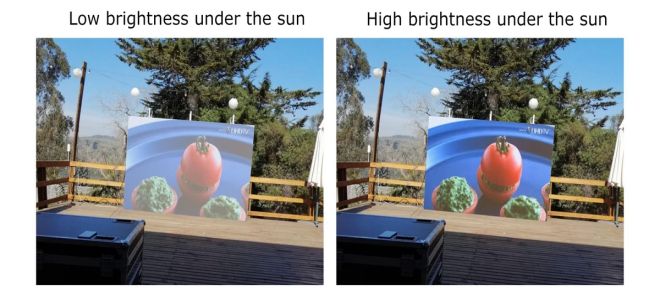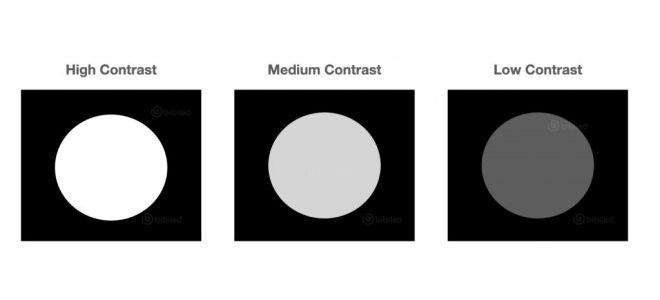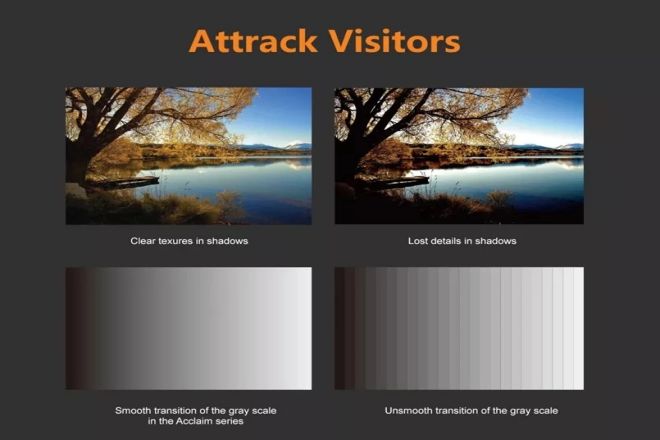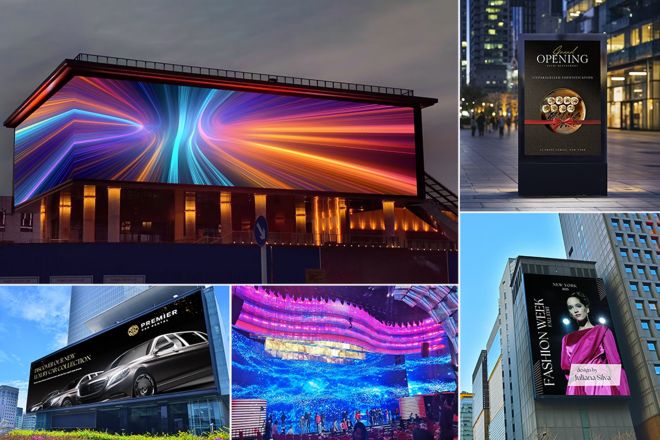소개

성과 지표 중 LED 디스플레이, 대비는 중요한 매개변수입니다. 이는 디스플레이 화면의 디스플레이 효과와 관객의 시각적 경험과 직접 관련이 있습니다.
대비도가 높은 LED 디스플레이는 더욱 생생하고 생생한 이미지를 표현하여 시청자가 그림 속의 다양한 요소를 구별하고 더욱 사실적인 시각적 경험을 얻을 수 있도록 해줍니다.
따라서 이 글에서는 LED 디스플레이에서 대비의 적용과 중요성에 대한 심층적인 설명을 제공할 것입니다. 여러분에게 도움이 되기를 바랍니다.
1. 대조 정의

대조는 기술적으로 들릴 수 있지만, 실제로는 우리 일상 생활에서 매우 흔한 시각적 현상, 즉 이미지에서 밝고 어두운 차이를 설명합니다. 햇살이 잘 드는 야외에서 실내로 걸어 들어갔을 때 밝고 어두운 대조적인 느낌이 대조의 표현이라고 상상할 수 있습니다.
LED 디스플레이에서 대비는 화면에서 가장 밝은 부분과 가장 어두운 부분 사이의 밝기 차이를 말합니다. 간단히 말해서, 그림에 밝은 흰색과 진한 검은색이 있으면 그림은 대비가 높고 더 선명하고 생생해 보입니다.
LED 디스플레이의 경우 대비의 중요성은 요리의 조미료만큼이나 필수적입니다. 화면을 볼 때 시각적 경험에 큰 영향을 미칠 수 있습니다. 고대비 LED 디스플레이는 밝은 색상과 강력한 3차원 효과가 있는 그림과 같으며, 보다 현실적이고 생생한 시각적 경험을 제공할 수 있습니다.
텍스트, 사진, 비디오 등 이미지의 모든 세부 사항을 선명하게 표시하여 최상의 디스플레이 효과를 표현할 수 있습니다.
반대로 LED 디스플레이의 대비가 충분히 높지 않으면 화면의 이미지가 흐릿하게 보이고 계층성과 입체감이 부족합니다. 화면에서 일부 세부 사항이 명확하게 보이지 않을 수 있으며, 이는 시청 경험에 큰 영향을 미칩니다.
따라서 쇼핑몰, 경기장, 영화관 등에서 우리가 그 선명하고 밝은 LED 디스플레이를 볼 때, 그 뒤에는 조용한 대조의 노력이 있습니다. 그것이 우리의 삶을 더 다채롭게 만들고 시각적 경험을 더 좋게 만듭니다. 따라서 LED 디스플레이를 선택할 때 대조는 분명히 집중해야 할 매개변수입니다.
대비를 계산하는 방법은 여러 가지가 있습니다. 일반적으로 사용되는 공식 중 하나는 다음과 같습니다.
대비 = (가장 밝은 픽셀 값 - 가장 어두운 픽셀 값) / (가장 밝은 픽셀 값 + 가장 어두운 픽셀 값).
이 공식은 회색조 이미지 또는 회색조로 변환된 컬러 이미지에 적용되며 계산된 대비 값은 [-1, 1] 사이입니다. 컬러 이미지의 경우 RGB 채널의 대비를 별도로 계산하여 전체 이미지의 대비로 평균화할 수 있습니다.
LED 디스플레이 화면의 실제 적용에서 대비 계산은 더 구체적입니다. 일반적으로 전체 화면의 밝기 분포를 고려합니다.
예를 들어, 화면의 밝기가 풀 화이트 화면 모드에서 500cd/m²이고 풀 블랙 화면 모드에서 0.5cd/m²이면 화면의 대비율은 1000:1입니다. 즉, 화이트를 표시할 때 화면 밝기는 블랙을 표시할 때보다 1,000배 더 밝아 더 높은 대비 효과를 얻을 수 있습니다.
2. 대비가 높을수록 좋습니다
대비가 높다고 해서 반드시 더 나은 것은 아닙니다. 구체적인 적용 시나리오와 개인적인 필요에 따라 판단해야 합니다.
일반적으로, 높은 대비는 실제로 더 생생한 이미지 효과를 가져올 수 있으므로 이미지의 밝고 어두운 부분을 잘 표시할 수 있으며, 이를 통해 시각적 경험의 사실성과 계층화를 강화할 수 있습니다. 고화질 비디오를 보거나, 게임을 하거나, 전문적인 이미지 디자인을 할 때, 높은 대비는 사진을 더 선명하고 세부적으로 만들어 사용자가 세부 사항을 더 잘 포착하고 색상을 구별하는 데 도움이 될 수 있습니다.
그러나 대비율이 너무 높으면 몇 가지 문제가 발생할 수도 있습니다. 예를 들어, 어떤 경우에는 대비율이 너무 높으면 이미지가 과다 노출되거나 너무 어둡게 나타나 일부 세부 사항이 손실되거나 색상이 왜곡될 수 있습니다. 또한, 대비가 높은 화면을 장시간 시청하면 눈의 피로나 불편함이 발생할 수 있습니다.
따라서 LED 디스플레이를 선택할 때 우리는 실제 필요에 따라 대비율을 고려해야 합니다. 풍부한 디테일과 색상을 표시해야 하는 애플리케이션 시나리오에서 사용하는 경우 대비율이 더 높은 디스플레이를 적절히 선택할 수 있습니다. 일상적인 사무 작업 및 웹 브라우징과 같은 더 간단한 애플리케이션 시나리오에서 사용하는 경우 적당한 대비율이 충분하며 너무 높은 값을 선택할 필요가 없습니다.
3. LED 디스플레이의 대비를 최적화하는 방법

대비는 LED 디스플레이의 설계 및 제조 공정에서 핵심 고려 사항입니다. LED 디스플레이의 대비를 개선하기 위해 LED 칩 기술, 디스플레이 구동 및 제어 시스템, 디스플레이 구조 설계와 같은 측면에서 최적화를 수행할 수 있습니다.
- LED 칩 기술의 발전
고휘도 LED 칩의 적용: 기술의 발전으로 LED 칩의 광 효율과 밝기가 크게 향상되었습니다. 고휘도 LED 칩을 사용하면 동일한 조건에서 화면의 밝기가 더 높아져 대비 효과가 향상됩니다.
고휘도 LED 칩을 적용하면 디스플레이 화면의 전반적인 밝기를 향상시킬 수 있을 뿐 아니라, 어두운 부분의 화면 밝기를 줄여 밝고 어두운 부분의 격차를 더욱 벌려 대비를 향상시킬 수 있습니다.
색상 재현 개선: LED 칩의 색상 성능을 최적화하는 것도 대비를 개선하는 중요한 수단입니다. 칩의 재료 및 구조 설계를 개선함으로써 LED 칩이 더 순수하고 채도가 높은 색상을 방출하도록 만들어 디스플레이의 색상 대비와 레이어링을 개선할 수 있습니다.
동시에, 색상 재현성이 향상되면 색상 왜곡도 줄어들어 그림이 더욱 사실적이고 자연스럽게 보입니다.
- 디스플레이 구동 및 제어 시스템 개발
그레이스케일 제어 기술의 최적화: 그레이스케일 제어 기술은 LED 디스플레이의 대비에 영향을 미치는 중요한 요소입니다. 그레이스케일 제어 기술을 최적화함으로써 화면 밝기를 더욱 미세하게 조정하여 이미지의 레이어링과 대비를 향상시킬 수 있습니다.
예를 들어, 고급 PWM 디밍 기술이나 FRC 기술을 사용하면 화면 밝기를 정밀하게 제어하고 디스플레이 효과를 개선할 수 있습니다.
동적 대비 조절 기술 도입: 동적 대비 조절 기술은 이미지 콘텐츠에 따라 실시간으로 화면 대비를 조절합니다.
이미지의 밝고 어두운 분포에 따라 화면의 밝기와 대비를 자동으로 조정하여 다양한 장면에서 최상의 대비 효과를 유지할 수 있습니다. 이 기술을 적용하면 LED 디스플레이의 시청 경험을 크게 향상시킬 수 있습니다.
- 디스플레이 구조 설계
반사 및 눈부심 방지 디자인: 야외 또는 강한 빛 환경에서 LED 디스플레이는 반사 및 눈부심 방지 디자인을 사용하여 화면 디스플레이에 대한 외부 빛의 영향을 줄여 대비를 개선할 수 있습니다. 이 디자인은 강한 빛 아래에서 화면의 반사 또는 눈부심을 효과적으로 방지하여 그림의 선명도와 대비를 보장할 수 있습니다.
시야각 범위 확장: 디스플레이 화면의 시야각 설계를 최적화함으로써 화면은 다양한 각도에서 좋은 대비 효과를 유지할 수 있습니다. 이는 대형 LED 디스플레이의 경우 특히 중요한데, 이는 종종 여러 방향에서 시청 요구 사항을 수용해야 하기 때문입니다. 시야각 범위가 확장되면 시청자는 다양한 위치에서 선명하고 대비가 높은 이미지를 볼 수 있습니다.
4. 다양한 LED 디스플레이 응용 분야에서의 대비의 구체적인 구현

LED 디스플레이의 핵심 성과 지표로서, 대비는 다양한 애플리케이션 시나리오에서 중요한 역할을 합니다. 다음에서는 대비가 상업 광고 및 미디어 커뮤니케이션, 라이브 스포츠 이벤트 및 라이브 디스플레이, 영화관 및 극장과 같은 엔터테인먼트 장소에 어떻게 반영되는지 자세히 설명합니다.
- 상업 광고 및 미디어 커뮤니케이션
상업 광고 및 미디어 커뮤니케이션 분야에서 고대비 LED 디스플레이는 특히 널리 사용됩니다. 고대비로 인한 시각적 충격은 광고 이미지를 더욱 눈길을 끌고 눈길을 끌게 하여 효과적으로 청중의 관심을 끌 수 있습니다.
이러한 강력한 시각적 효과는 광고 정보의 전달 효과를 강화하고, 광고의 매력과 기억성을 향상시키는 데 도움이 됩니다.
또한, 고대비 LED 디스플레이는 광고 이미지의 실제 색상과 세부 사항을 복원하여 이미지를 더욱 생생하고 사실적으로 만들 수 있습니다. 이는 광고의 질을 향상시키고, 브랜드 이미지를 강화하며, 상인에게 더 나은 홍보 효과를 제공하는 데 도움이 됩니다.
- 스포츠 이벤트 라이브 방송 및 라이브 디스플레이
스포츠 경기의 라이브 방송과 현장 디스플레이 측면에서도 고대비 LED 디스플레이는 중요한 역할을 합니다. 스포츠 경기에서 스포츠 이미지의 정확한 프레젠테이션은 관객에게 매우 중요합니다.
고대비 디스플레이 화면은 선수들의 모든 움직임과 세부 사항을 선명하게 보여주어 관객은 마치 그 자리에 있는 것 같은 느낌과 경기의 흥분을 느낄 수 있습니다.
또한, 고대비 디스플레이는 화면의 그림자와 반사를 줄여 시청자가 다양한 각도와 조명 조건에서 최상의 시청 경험을 얻을 수 있도록 보장합니다. 이는 관객의 참여와 만족도를 높이는 데 도움이 되며 스포츠 이벤트의 커뮤니케이션과 홍보에 강력한 지원을 제공합니다.
- 영화관, 극장 등 엔터테인먼트 시설
영화관이나 극장과 같은 엔터테인먼트 장소에서 고대비 LED 디스플레이는 관객에게 몰입감 넘치는 시청 경험을 제공합니다. 고대비는 그림의 밝고 어두운 부분의 대비를 더욱 생생하게 만들고 세부 사항을 더욱 풍부하게 만들어 더욱 사실적이고 입체적인 이미지 효과를 만들어냅니다.
이러한 몰입형 영화 관람 경험은 관객이 영화나 공연에 더 몰입하여 감정과 분위기를 느끼는 데 도움이 됩니다.
또한, 고대비 디스플레이는 작품의 원래 색상과 질감을 복원하여 관객이 작품의 의미와 스타일을 더 깊이 이해할 수 있도록 합니다. 이는 작품의 시청 가치를 높이고 관객의 예술적 감성을 향상시키는 데 도움이 됩니다.
결론
LED 디스플레이에서 명암비의 중요성을 심도 있게 살펴보면, 명암비가 LED 디스플레이 성능의 핵심 요소 중 하나라는 것을 쉽게 알 수 있습니다.
이는 디스플레이 효과의 선명도와 레이어링에 직접 영향을 미치며, 이는 다시 청중의 시각적 인식을 결정합니다. 따라서 대비를 선택할 때도 특별한 주의를 기울여야 합니다.
마지막으로 LED 디스플레이에 대해 더 알고 싶으시다면, 우리에게 연락해주세요.
